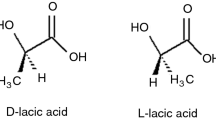Abstract
The effects of the glass transition and the operating process on the hardness of thermally compressed maltodextrin were investigated. The hardness of compressed maltodextrin increased significantly when it was compressed above the glass transition temperature (Tg). Maltodextrin compressed before heating showed much higher fractural stress than that compressed after heating due to the difference in force required for constant deformation. There was no effect of the decompression temperature being above or below Tg. Furthermore, the effect of crystalline additives (NaCl, monosodium glutamate monohydrate, sucrose, lactose monohydrate, lauric acid, and stearic acid) on the hardness of maltodextrin compressed above Tg was investigated. The hardness of compressed maltodextrin decreased with increasing crystalline additives except for hydrate crystals at a low-additive fraction. Since crystalline additives existed as dispersions in amorphous maltodextrin, the compressed maltodextrin became fragile by the addition of crystalline materials. In the case of hydrate crystals, it is thought that the hydrate crystals melted at the interface, releasing water molecules that formed an intermolecular binding layer. Stearic acid formed a solid by itself. Stearic acid has an intrinsically much lower melting temperature than the other crystals, and interfacial melting would have occurred in the compressed stearic acid itself.







Similar content being viewed by others
References
Gupta S, Bongers P (2011) Bouillon cube process design by applying product driven process synthesis. Chem Eng Process Process Intensif 50(1):9–15. https://doi.org/10.1016/j.cep.2010.10.008
Lakio S, Ylinärä H, Antikainen O, Räikkönen H, Yliruusi J (2015) Spectroscopic insight for tablet compression. Eur J Pharm Biopharm 90:16–21. https://doi.org/10.1016/j.ejpb.2014.11.010
Persson A-S, Alderborn G (2018) A hybrid approach to predict the relationship between tablet tensile strength and compaction pressure using analytical powder compression. Eur J Pharm Biopharm 125:28–37. https://doi.org/10.1016/j.ejpb.2017.12.011
Sun CC (2015) Dependence of ejection force on tableting speed—a compaction simulation study. Powder Technol 279:123–126. https://doi.org/10.1016/j.powtec.2015.04.004
Thapa P, Lee AR, Choi DH, Jeong SH (2017) Effects of moisture content and compression pressure of various deforming granules on the physical properties of tablets. Powder Technol 310:92–102. https://doi.org/10.1016/j.powtec.2017.01.021
Angell CA, Bressel RD, Green JL, Kanno H, Oguni M, Sare EJ (1994) Liquid fragility and the glass transition in water and aqueous solutions. J Food Eng 22:115–142. https://doi.org/10.1016/0260-8774(94)90028-0
Roos YH (1995) Phase transitions in foods. Academic Press, San Diego https://doi.org/10.1016/B978-0-12-595340-5.X5000-7
Fongin S, Kawai K, Harnkarnsujarit N, Hagura Y (2017) Effects of water and maltodextrin on the glass transition temperature of freeze-dried mango pulp and an empirical model to predict plasticizing effect of water on dried fruits. J Food Eng 210:91–97. https://doi.org/10.1016/j.jfoodeng.2017.04.025
Boonyai P, Howes T, Bhandari B (2007) Instrumentation and testing of a thermal mechanical compression test for glass–rubber transition analysis of food powders. J Food Eng 78(4):1333–1342. https://doi.org/10.1016/j.jfoodeng.2006.01.005
Mochizuki T, Sogabe T, Hagura Y, Kawai K (2019) Effect of glass transition on the hardness of a thermally compressed soup solid. J Food Eng 247:38–44. https://doi.org/10.1016/j.jfoodeng.2018.11.019
Malamataris S, Pilpel N (1980) The effect of temperature on the tensile strength and densification of lactose powder coated with fatty acids. Powder Technol 26(2):205–211. https://doi.org/10.1016/0032-5910(80)85063-7
Ramos MA, Moreno JA, Vieira S, Prieto C, Fernández JF (1997) Correlationof elastic, acoustic and thermodynamic properties in B2O3 glasses. J Non-Cryst Solids 221(2–3):170–180. https://doi.org/10.1016/S0022-3093(97)00368-2
Kawai K, Hagura Y (2012) Discontinuous and heterogeneous glass transition behavior of carbohydrate polymer–plasticizer systems. Carbohydr Polym 89(3):836–841. https://doi.org/10.1016/j.carbpol.2012.04.018
Haque MK, Kawai K, Suzuki T (2006) Glass transition and enthalpy relaxation of amorphous lactose glass. Carbohydr Res 341(11):1884–1889. https://doi.org/10.1016/j.carres.2006.04.040
Atake T, Angell CA (1979) Pressure dependence of the glass transition temperature in molecular liquids and plastic crystals. J Phys Chem 83(25):3218–3223. https://doi.org/10.1021/j100488a007
Takeiti CY, Kieckbusch TG, Collares-Queiroz FP (2010) Morphological and physicochemical characterization of commercial maltodextrins with different degrees of dextrose-equivalent. Int J Food Prop 13(2):411–425. https://doi.org/10.1080/10942910802181024
Lange NA, Forker GM (1967) Handbook of chemistry. Mcgraw-Hill Book Company, New York
Sano C, Kawakita T, Nagashima N, Iitaka Y (1989) Crystal and molecular structures of monosodium L-glutamate monohydrate. Anal Sci 5(1):121–122. https://doi.org/10.2116/analsci.5.121
Berggren J, Frenning G, Alderborn G (2004) Compression behavior and tablet-forming ability of spray-dried amorphous composite particles. Eur J Pharm Sci 22(2–3):191–200. https://doi.org/10.1016/j.ejps.2004.03.008
Van Veen B, Van Der Voort Maarschalk K, Bolhuis GK, Zuurman K, Frijlink HW (2000) Tensile strength of tablets containing two materials with a different compaction behavior. Int J Pharm 203(1–2):71–79. https://doi.org/10.1016/S0378-5173(00)00450-6
Tufvesson F, Wahlgren M, Eliasson AC (2003) Formation of amylose-lipid complexes and effects of temperature treatment. Part 2. Fatty acids. Starch/Stärke 55:138–149. https://doi.org/10.1002/star.200390028
Fan F, Roos YH (2016) Structural relaxations of amorphous lactose and lactose-whey protein mixtures. J Food Eng 173:106–115. https://doi.org/10.1016/j.jfoodeng.2015.10.047
Rabinovich YI, Esayanur MS, Moudgil BM (2005) Capillary forces between two spheres with a fixed volume liquid bridge: theory and experiment. Langmuir 21:10992–10997. https://doi.org/10.1021/la0517639
Aguilera JM, del Valle JM, Karel M (1995) Caking phenomena in amorphous food powders. Trends Food Sci Technol 6:149–155. https://doi.org/10.1016/S0924-2244(00)89023-8
Wang Z, Prashanth KG, Surreddi KB, Suryanarayana C, Eckert J, Scudino S (2018) Pressure-assisted sintering of Al–Gd–Ni–Co amorphous alloy powders. Materialia 2:157–166. https://doi.org/10.1016/j.mtla.2018.07.010
Acknowledgments
We acknowledge San-ei Sucrochemical Co., Ltd. (Aichi, Japan) for providing MD.
Author information
Authors and Affiliations
Corresponding author
Ethics declarations
Conflict of Interest
Kiyoshi Kawai (corresponding author) received a collaborative research fund from San-ei Sucrochemical Co., Ltd. (Aichi, Japan) for a purpose different from this study. The sponsor had no control over the interpretation, writing, and publication of this work.
Additional information
Publisher’s Note
Springer Nature remains neutral with regard to jurisdictional claims in published maps and institutional affiliations.
Rights and permissions
About this article
Cite this article
Mochizuki, T., Alvino Granados, A.E., Sogabe, T. et al. Effects of Glass Transition, Operating Process, and Crystalline Additives on the Hardness of Thermally Compressed Maltodextrin. Food Eng Rev 13, 215–224 (2021). https://doi.org/10.1007/s12393-020-09236-x
Received:
Accepted:
Published:
Issue Date:
DOI: https://doi.org/10.1007/s12393-020-09236-x




